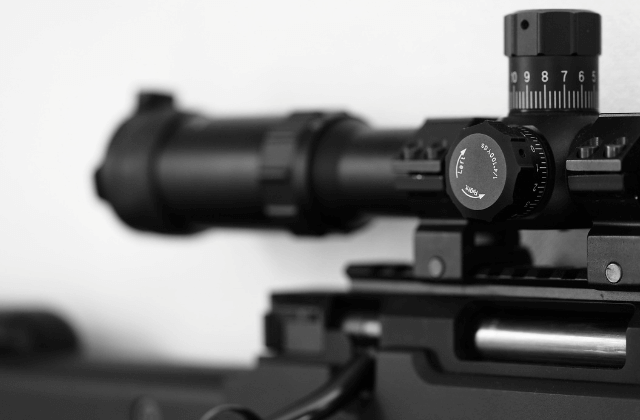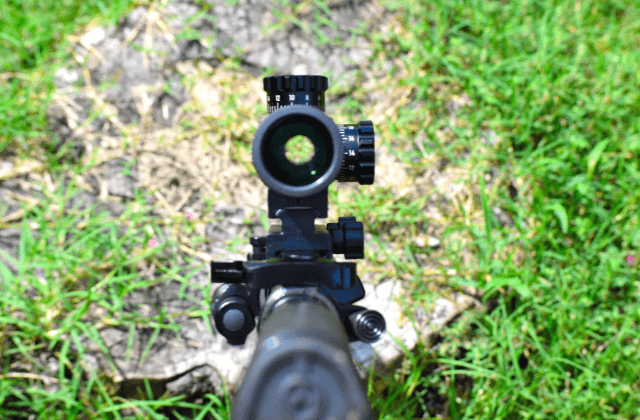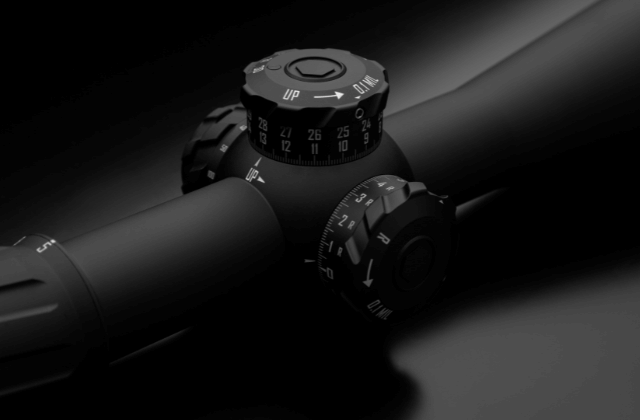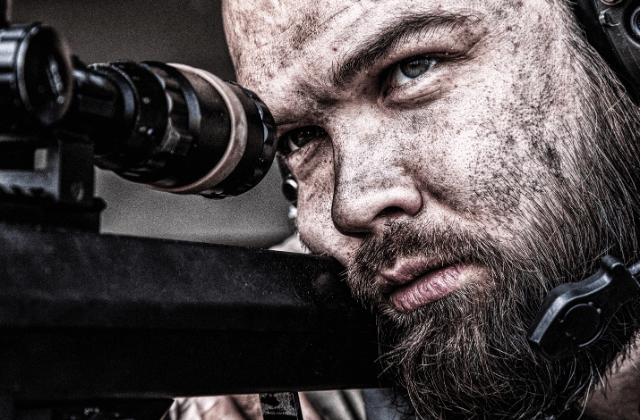This site contains affiliate links. As an Amazon Associate, I earn a commission from qualifying purchases at no extra cost to you. Full Disclosure Here.
The numbers and designations on a rifle scope can be confusing even for experienced shooters and downright incomprehensible for those new to long-range shooting. Today we’re going to take a close look at just what all those numbers mean and how to decipher all of the markings and designations on a rifle scope.
We’re going to go over fixed and variable magnifications, objective lens sizes, and how to choose the right magnification for your specific needs. Whether you’re looking for a scope for hunting, target shooting, or long-range precision shooting, all your questions should be answered.
What Does the Numbers on a Rifle Scope Mean?
The first number (or set of numbers) on a rifle scope (the one before the X) refers to the magnification strength. The second number (the one after the X) refers to the diameter of the objective lens. It’s always in millimeters, even if a unit of measurement is not provided.

Now let’s break these down a little bit more, one at a time.
First, let’s talk about the first number: the scope’s magnification. The magnification of a scope refers to how many times larger items will look through the scope compared to the naked eye, which is why the magnification strength is followed by an X or multiplication symbol (✕).
For example, a 2x scope will show objects at twice the size they would appear in real life, while objects viewed through a 4x scope will appear four times as large as they would when viewed with the naked eye.
However, there are also variable magnification scopes. These scopes have two numbers before the X, representing the range of magnification settings available on the scope. The first number is the scope’s minimum magnification setting and the second number is the scope’s maximum magnification setting.
So a 3-9x scope will have a minimum magnification of 3x and a maximum magnification of 9x. Of course, you can also use additional magnification levels in between 3x and 9x. And it’s continuous, so you can set the magnification anywhere between those two ranges, not just at fixed values.
Variable magnification scopes are nice because they are more versatile. However, they’re also heavier and require more time to set the right magnification strength.
The final number on a scope — the one after the X — refers to the diameter of the objective lens. The objective lens is the lens on the far end of the scope, on the end towards the target and away from your eye.
So why does objective lens diameter matter? Well, generally speaking, a larger objective lens means a brighter, clearer sight picture. However, bigger isn’t always better.
A larger objective lens adds additional weight and will also require you to mount the scope higher to accommodate the lens. Furthermore, the size of the objective lens is far from the only factor contributing to the quality of your scope’s image. The quality of the glass is also important, as are the lens coatings used by the manufacturer.
Visit our article on How to zero a scope by Marine Approved.
How to Pick the Right Scope Magnification
Choosing the right scope magnification is a key part of being successful in whatever rifle shooting discipline you’re taking part in. We’re going to look at some key considerations to help you pick the right magnification and style of scope.
Type of Shooting
One of the first considerations should always be the type of shooting that you’re doing. For something like F-Class benchrest shooting, you’ll want a very different type of scope from, say, a hunter looking to lay down a whitetail from 200 yards away in the backwoods.

Tailoring your scope to the type of shooting you’re doing will help ensure that you get the best performance.
For precision target shooting, for example, you’ll typically want a more powerful scope than you would for hunting, even at the same distance. This is because a lower magnification scope allows you to more easily find and track a moving target, which isn’t usually an issue with target shooting.
Of course, all hunting isn’t the same. The larger the game, the less magnification you want. For small game, you need to be able to zoom in tighter, but using that same magnification for large game makes it hard to find the right spot for an ethical kill.
And, of course, target shooting isn’t all the same either. You’ll also need to choose the right magnification for the type of target you’re shooting and the distance between you and it. But we’ll get into the distance more in a second.
3-9x is probably the most popular magnification for hunters, while PRS shooters go higher with 5-25x. Benchrest shooters go even higher but typically prefer fixed magnification scopes, with a magnification of around 40x.
Distance
As you can probably guess, the further you want to shoot, the greater the magnification you need.
You probably already have a good idea of how far you need to shoot, especially if you’re looking for a scope specifically for target shooting. Target shooting is easy.
If you’re looking for a hunting scope, though, it can be a bit trickier. The main thing to think about is where you’ll be hunting. Hunting in the Southeastern United States, for example, generally involves shots within a couple hundred yards. Hunting in the Rockies, on the other hand, can involve shots from the side of one mountain to the next, up to about 500 yards.
Exactly what magnification you need will depend on what you’re hunting, but let’s use medium-range big game as a starting point. Generally, for this type of hunting, you’ll want about a 2-7x or 3-9x scope. Go higher for small game and longer distances, and lower for short-range.
LPVOs, or low-powered variable optics, come in variable magnifications like 1-6x, 1-8x, or 1-10x and are a great option for most competition-style shooting that’s not reaching out to 500 yards or more.
These scopes offer what is essentially a red dot, with all of the fast target acquisition and rapid reaction times that offers, plus the ability to dial up the magnification for a long-range shot quickly. This makes them great for hunting dangerous game like hogs or bears, or for multi-distance competition like 3Gun.

If you’re reaching out a bit further for something like Precision Rifle Series, which has targets all the way out to 1,200 yards or so, you’ll want something with a lot more magnification. Shooters in this type of situation usually want a 4-16x at the minimum and can go all the way up to 7-35x and beyond, depending on their preferences.
Rifle Caliber
Your caliber will also influence your decision when it comes time to pick a scope. For example, your .22LR, as accurate as it may be for close-range bench-rest, is never going to need to reach out to 1000 yards, so the type of scope you need will be more like a 3-9x hunting scope than the Hubble Telescopes used in something like PRS.
For bullseye benchrest shooting, more magnification is needed, but for what rimfire calibers are typically used for (plinking, small-game hunting, target practice) you really don’t need a lot of magnification.
Similarly, if you want to get the most out of your .338 Lapua or .300 PRC, then you really need a scope that can go the distance and let you work out to at least 1,500 yards without any issues. Unless of course you’re hunting with that rifle, in which case something like a 4-16x is more than enough usually.
Your Eyesight
If you have poor eyesight, it might be tempting to go with a more powerful scope, but this may actually have the opposite of the effect you want. You see, higher magnification means more optical distortion, and poor eyesight, especially aging eyes, can make that distortion even worse.

Be sure to go with a magnification level typical for the range and activity or even a little bit lower to limit some of the optical distortion. Instead of focusing on higher magnification, prioritize excellent glass quality, fully multicoated lenses, a large objective lens, and long eye relief. An illuminated reticle can also be a huge help.
Visit this article on MOA vs MRAD Rifle Scopes by Megan Kriss.
Additional Considerations
Struggling to choose because you might use the scope in multiple situations? Choose a scope for the conditions under which you’ll be shooting the majority of the time. Scopes are versatile, especially variable magnification scopes. They can generally do just fine some ways outside of their ideal conditions.
It’s also generally better to err to the side of lower magnification than higher, especially for a hunting scope. For one, lower magnification scopes are lighter and more affordable, but also you’re more likely to need to make shots at targets that are closer than anticipated than targets farther away.
FAQs
The numbers on a 4×16 scope mean that the scope has 4x magnification and an objective lens with a 16mm diameter. These types of scopes are typically overkill for most types of hunting, and are used for long range precision shooting, such as PRS competition shooting or long-range varmint hunting.
A 3-9×50 scope is a variable magnification scope with a 3x minimum magnification and a 9x maximum magnification. The 50 means that the scope’s objective lens is 50mm in diameter. This is a versatile magnification range and a nice, large objective lens. It’s great for many purposes, from hunting to competition to recreational shooting.
The standard scope of US military snipers has a 10x magnification and an adjustable parallax from 10 yards to infinity. This type of scope is ideal for long-range shots, from about 250 yards to about 1,000 yards. However, for shots under 250 yards, the high power is actually a disadvantage.
Conclusion
You should now know everything you need to know about rifle scope magnifications and what all those numbers mean on the side of the box and scope.
We know it can be a bit confusing at first, but hopefully, it’s all cleared up now. All you have to do is remember that it’s written as “Magnification range x objective lens diameter in millimeters,” and you should be good to go.
And if you’re struggling to choose a scope, our guide above should tell you everything you need to know.
Still have questions? Shoot us a comment down below.

